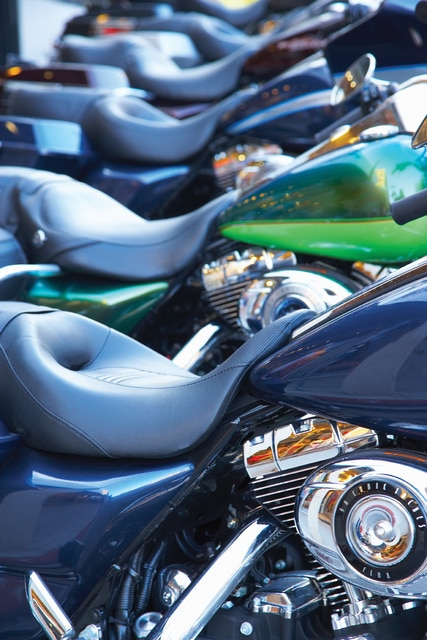

DARKE COUNTY — Because of the death of a young motorcyclist in Jefferson Township, Ohio, recently, a local family wants the public to be reminded about motorcycle safety.
The local family, who asked not to be identified because this loss is still raw to them, said the young man’s name is 23-year-old Brandon Gibson, who died as a result of his cycle going out of his control on wet, mown grass on the roadway.
“He was headed for work, traveled over a hill in the roadway which he was familiar with and below that is a stop sign,” said one of the local family members.
It was then that his vehicle apparently hit the wet grass and ejected him early one morning at the corner of Infirmary Road and Germantown Pike.
“I just want to get the word out as to how dangerous the simple act of blowing grass onto the roadway can be,” said the family member.
With that, here are some other motorcycle safety tips that were found on the Internet:
There are three ways riders should ready themselves for a ride.
• First, there is mental readiness. Before taking your bike out, your mind should be clear and drug and alcohol free in order to focus on the ride you have ahead of you.
• Second, you must be physically prepared. Protective gear is a must in protecting your body while riding a motorcycle. Protective gear includes: a good fitting helmet, gloves, eye protection, jacket, long pants, and sturdy boots or shoes. Note that reflective or bright colored protective gear will help you stand out in traffic. Physical fitness will help your riding in countless ways including, comfort on longer rides and better and sharper reflexes. Also, try some stretching exercises before you ride.
• Third, you must check the condition of your bike. This includes fixing the parts that break, as well as regular maintenance, such as: regular oil changes, properly adjusted controls, a properly adjusted chain and suspension, good tires, working turn signals, and checking of tire pressure. A quick walk around the bike before riding could point out leaks, loose bolts, tire problems, or anything else out of place.
• Be smooth. It takes plenty of concentration, but smooth control of your ride has plenty of specific benefits. Your fuel economy improves dramatically and you are less likely to lose traction due to an overzealous use of the throttle. Smooth riding includes matching the engine speed to the proper gear and road speed. Having your bike in the right gear keeps the power for accelerating or engine braking close at hand, while also keeping the bike running along smoothly. You maintain your best traction when your inputs are smooth, including your steering inputs. Harsh or abrupt pressure on the handlebars can upset the suspension. Smooth, firm counter steering keeps the bike on your desired line and creates little instability in the suspension. Your tires, brakes, suspension, and bearings will last longer, too. Smooth riding makes for less wear and tear on your bike.
• Know where you are. Being aware of what is in your immediate space cushion will always help you guide your ride safely. Failure to be aware of your position in relation to those around you can cause dire consequences when faced with the need to make a quick lane change. Pay special attention to what’s in front of you, especially oncoming traffic. It’s easy to disregard traffic traveling in the opposite direction but that is where the greatest threat lies.
•Use your head to look where you’re going. This may sound slightly remedial but it is an under-appreciated habit of a skilled rider. As you round a turn, keep your head and eyes up, looking through the corner as far as you safely can, at least three to four seconds ahead. (If you can’t see that far ahead, you need to slow down until you CAN see three to four seconds ahead).
• When your line of sight or path of travel becomes restricted, reduce your speed and use great care. Simply put, if you can’t see, slow down. Rain and fog are examples of situations where less speed = more reaction time = safer riding. Curvy forest and mountain roads’ sightlines are shorter; you need to reduce your speed to be prepared for surprises like deer or big rocks.
• Before proceeding through any intersection, check left, check front, check right, then check left again. As you enter an intersection, whether turning or proceeding through, you need to know what your hazards are and where they can come from. The highest priority is to check your left. Why left? The left is the highest priority because that is the lane of traffic you first cross and therefore would be the first to impact you. After the left you continue to check the intersection in a clockwise pattern, and then check left again. You check the left twice because in the time it takes to check all other directions, the situation has probably changed to the left.
• Check your rear-view mirror before you slow your speed. Too often, what is out of sight is out of mind. As you slow down for any turn or a stop, you need to be aware of what is happening behind you. At the moment you begin braking or rolling off the throttle, you need to check your mirrors. (Your attention up to this point has been primarily in front of you, so once you start braking, you are already minimizing any hazards in that direction). This is part of your general awareness of what is happening in your surroundings on the road. The habit to acquire is to check your mirrors every five to seven seconds, and also any time you roll off the throttle. Combine that with gentle application of both brakes and rarely will a stop be anything more than routine.





